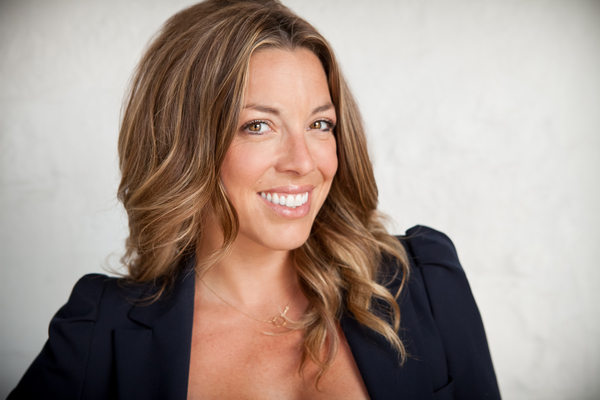Carnahan worked in local paper mill and was only 21 at the time of the tragedy

One day, Carnahan took a shortcut that she had seen everybody else take many times before: stepping over a conveyor belt. But this time, her foot went down and got caught in a pinch point where the conveyor belt came together. It pulled her foot into the machine, which kept running for a few seconds, until a co-worker heard her screaming and pushed the manual stop button.
“That’s what saved my life. It seized the system but I was clearly stuck in there too far to get out,” says Carnahan, recalling it took about 20-30 minutes before she got out. “I remember a lot of it but it’s kind of like a very vivid blur. I remember the pain because I still get phantom pain, so when I get it really badly, it will remind me of what it felt like in the machine.”
Carnahan’s toes were removed in the conveyor belt and, as a result, her left leg had to be amputated. The former cheerleader, ballet dancer and mini-skirt-loving young woman now had a prosthetic leg. One would imagine this would leave her angry, frustrated, depressed or any other slew of normal post-incident emotions, but Carnahan bypassed all of that.
“I really didn’t feel too sorry for myself,” she says. “I really was thinking, ‘This happened. It’s done and it sucks.’ And I was in a lot of physical pain, but I really just thought, ‘I need to make the best of it. I need to fake it ‘til I make it.’”
Just one year after her injury, Carnahan had graduated from university and was approached by the prevention arm of the New Brunswick workers’ compensation board to speak to high school students about workplace safety. Then, she started travelling across Canada with another safety advocate, Paul Kells, to get employers and young workers on the same page when it comes to safety. Now, Carnahan is a highly sought-after keynote speaker who travels across North America and the world sharing her story at schools, companies, conferences and events.
Carnahan believes safety training has to be relevant to young workers in order for the message to really hit home — unlike what she received at the mill.
“Videos of people who I would have thought, at age 19, were my grandfather’s age. So it’s like, ‘OK, yeah, you got hurt, but you’re old.’ And you can’t help it. That’s just what you think. Your brain is not developed. When you’re 19, you do not relate to that person,” she says.
It’s also very important for safety to be more than just posters and policies. At the paper mill, there were signs everywhere that boasted health and safety, but there were unsafe machines being used, guards being taken off, emergency stop systems being disabled and shortcuts being taken.
Despite all this, Carnahan takes responsibility for her incident.
“I wasn’t paying attention to what I was doing. I didn’t think anything could happen to me. I did what everyone else was doing without thinking it through and without thinking what the consequences could be,” she says. “Nobody forced me over the machine, nobody pushed me; I did it.”
Thinking that nothing bad can happen to you is a notion that Carnahan tries to dispel in her keynote speeches.
“If it’s happening somewhere, it can happen to you. Nobody looks like somebody who is going to get killed today. When you are brushing your teeth in the morning, you don’t look in the mirror and look like someone who is going to get hurt at work,” she says.
Carnahan acknowledges combating complacency is one of the greatest challenges facing health and safety managers. She recommends they take a tough love approach.
“If a rule is made, it’s made for a reason and there should not be these ‘three strikes you’re out.’ If you’re not complying with the rules, then there is somebody else whose looking for work and who can do the job, hopefully, the right way and not put people’s lives at risk,” she says. “Once they see people getting sent home, it won’t take long.”
Employees need to understand safety managers are being strict on safety not just for the sake of following rules, but because they are legally responsible for the well-being of their workforce and because they truly care. If employees are annoyed by all the rules, don’t take it personally.
“I would rather have somebody angry with me than be going to their funeral because I didn’t enforce the rules and that was my job,” Carnahan says.
She also recommends weaving personal stories into the safety program to help get buy-in from workers.
“There’s lots of people out there who have stories to tell,” she says. “As long as people are being touched personally, I think that all of those systems and rules, the investment in those programs is tenfold because people have a personal reason why they’re adhering to them,” she says.
Carnahan is a firm believer in making sure workers say something if they see something — a message that must be imparted to young workers and handled delicately.
“If they have the courage to care enough to speak up to try and let you know what you’re doing is unsafe, you can’t shoot that down because they will never say anything again. That’s the worst thing you can do,” says Carnahan.
When workers do speak up, it’s important to keep them up to date on any corrective actions, she says.
“I hear a lot of times people say, ‘Yeah, well I told them but they don’t listen’ or ‘Yeah, I mentioned that but I never heard anything back about it.’ So, maybe someone’s reported something and maybe you can’t fix it immediately... but don’t go to another toolbox meeting and not address that that was brought up.”
Another one of Carnahan’s key messages is “focus on focus,” meaning workers need to be mindful and ensure they are focusing on the task at hand.
“It’s training yourself not only to be looking for blinking lights and caution tape, hazards, hazards, hazards, but understanding that lack of focus in itself is a hazard,” says Carnahan.
For example, if a worker had a fight with her spouse that morning and finds herself thinking, “I wish I had of said this or that,” she has lost focus and that can contribute to incidents.
“The minute your mind is wandering, you’re not present. If you’re on the plant floor, you’re working with other people, you’re working around moving machinery, if you’re off in the clouds, thinking about something that is completely unrelated to where you are, your guard is down.”
When Carnahan reflects upon the day of her incident, she is especially grateful that her mother was off that day — she worked in the mill’s accounting department. No one ever wants to see a loved one in a situation like that. And that’s always Carnahan’s response to the safety critics: If you can’t be safe for yourself, do it for the people who love you.
“It’s people who have been in the job for however long and they think their way is the best way and ‘These new safety rules are for suckers.’ Maybe you don’t care, but somebody does and that somebody will probably suffer more pain than you if you don’t smarten up.”
Amanda Silliker is the editor of COS magazine.
This article originally appeared in the October/November 2017 issue of Canadian Occupational Safety.





